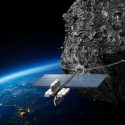Earth is the only life-supporting planet in our Solar System. Until now. Today, we’re bringing Kepler 22-b into our planetary neighborhood. Where would this planet need to orbit within the Sun’s habitable zone? How would you go visit it? And would you find life when you get there?
Located 635 light-years away from Earth, Kepler 22-b is the first exoplanet discovered inside of the habitable zone of a Sun-like star. And that means Kepler 22-b has a chance to be covered with liquid water. While it’s still not known whether it’s rocky, gaseous or liquid, we do know that it’s pretty big. Kepler 22b is almost 2.5 times larger and about 36 times more massive than Earth.
Based on its distance from its own star, in our Solar System, Kepler 22-b would exist somewhere between Earth and Venus. If it orbited there, you’d get a magnificent view of the planet in the night sky. It would appear about as large as 15% of our own full Moon. But our Sun is slightly bigger and hotter than its host star, Kepler 22. And that increase in temperature might make it too hot to host life.
And why should Kepler 22-b get its own orbit, when it could share ours. What could possibly go wrong with that? If Kepler 22b was to snuggle comfortably into our own orbital path, there are only a few places it would be able to go. They’re caled Lagrange points. One of these points would be on the exact opposite side of the Sun from Earth.
But unfortunately, that would come with a few downsides. For starters, you wouldn’t ever be able to see it. That’s because it would always be behind the Sun from our perspective down here on Earth. But worse than that, this location wouldn’t guarantee it a stable orbit. It could get derailed and head directly toward Earth.
That would be the end of life on both worlds. But at least you could end up with a decent view when the two planets were on a direct collision course with each other. The better, more stable option would be for Kepler 22-b to nestle into orbit at the Lagrange points located 60 degrees ahead of and behind Earth.
Here, a third body could maintain a consistent orbit around the Sun and not get gravitationally pulled into Earth. Then, Kepler 22-b would have a chance of hosting its own life. This planet is about 500 million years younger than Earth. And if it formed in our Solar System at about the same time Earth did, it would have more than enough time for various life-forms to evolve.
Maybe even intelligent ones. It would be so amazing to visit our neighbor and maybe even establish communication with whoever, or whatever, inhabited Kepler 22-b. But even with this new Earth 2.0 safely sharing our habitable spot around the Sun, getting there would be a bit of a challenge.
Our planet is constantly being pulled toward the Sun by its enormous gravity. But it’s always trying to move straight into space at the speed of 108,000 km/h (67,000 mph). So if we wanted to visit Kepler 22-b, we’d have to manage to counteract that sideways motion of our planet. Otherwise we’d keep moving sideways and we’d miss our new planetary neighbor.
So the best thing you could do is swing around Venus for a little gravity assist. This is a technique that allows your spacecraft to increase or decrease the energy of its orbit. In other words, you could use Venus to slow down and arrive at your destination. All these maneuvers would still require a lot of fuel. And time.
The trip to Venus alone would take you about four months. And then you’d have to apply the gravitational brakes while approaching Kepler 22-b, adding even more time to the journey. But finally you’d arrive and be the first person ever to see this massive Earth-like planet up close. And the first thing you’d notice is that it would be rotating on its side, just like Uranus.
This would mean that its north and south poles would either be flooded by sunlight or shrouded in total darkness for six months of the year. You’d discover the climate might not be as pleasant as you might have hoped. Your two options would be freezing cold, or boiling hot. But you shouldn’t lose hope.
There’s a strong possibility you could find that Kepler 22-b is covered in a superocean. And if it was at least 50 m (165 ft) deep, this ocean could regulate these temperature extremes. As you landed, you could even find them within a comfortable range of 15 to 22 °C (60-72 °F). But that wouldn’t be an indicator to take your spacesuit off just yet.
There’s still the possibility that 22-b wouldn’t have a breathable atmosphere. No matter what kind of environment you’d find, you’d need to build yourself a habitat. This would help you maintain air pressure, temperature and the composition of the air you’d need to breathe. You could even 3D print this habitat using the planet’s resources.
And you’d want to make sure it could protect you from radiation, just like our own atmosphere and magnetic field. Right now, we really don’t know all that much about this not-so-distant exoplanet. But if Kepler 22-b was in our Solar System, that would give us plenty of time to send space probes and study it before you ever set your foot on the surface.
As a result, by the time you started your mission to Earth 2.0, you’d already know what kind of temperature and air this world had. If Kepler 22-b was so close to us, settling on it could be easier than moving to Mars. Once you settled on the planet, you’d start desalinating its ocean water and set up hydro and solar power stations.
Food, on the other hand, would be a bit tricky. Initially, growing plants from Earth would require greenhouses with regulated temperatures and humidity levels to keep your favorite potatoes from dying. As you studied the planet more, outdoor gardens could become a reality.
Or you could start developing a taste for the high-protein algae that you might find growing in the superocean. And if you’re really lucky, you could discover life. Maybe even intelligent life. But none of that is possible since Kepler 22-b didn’t form in our Solar System. If you ever wanted to land on its alien surface, you’d need to travel hundreds of light-years and be prepared to overcome a long list of obstacles. So what if you did travel all the way to Kepler 22-b?
Sources
- “Kepler-22B – Exoplanet Exploration: Planets Beyond Our Solar System”. 2022. exoplanets.nasa.gov.
- “Kepler-22b could be inhabited”. John von Radowitz. 2011. independent.co.uk.
- “Don’t Pack Your Bags Yet – Kepler-22B (Probably) Isn’t The Next Earth”. 2011. theconversation.com.
- “NASA Confirms Earth-Like Planet, Kepler-22B Could Hold Life- Technology News, Firstpost”. 2011. firstpost.com.
- “Finding A New Earth”. 2021. nasa.gov.



























